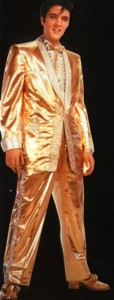What Do Our Digital Appearances Say About Us?
Seldom do people discern eloquence under a threadbare cloak.
–Juvenal
Home is not a game. Home is a virtual society. And, as such, we prejudge people based on various indicators — just as we do in real life.
Let’s cut through pretense for a moment. In real life, we size each other up with every single interaction. At the most absolutely basic level, two basic categories are checked off:
- Is this someone I could defeat in a fight?
- Is this someone I want to mate with?
Beyond that, we then evaluate each other on a more social level:
- Is this someone I want to conduct business with?
- Is this someone I can trust?
- Is this someone I can relate to?
- Is this someone I want to interact with?
- Is this someone who will help me achieve my goals?
And so forth.
Here’s an example. Recently, I popped into Radio Shack to grab some components. The first sales associate who greeted me was borderline unkempt and had a bad case of what appeared to be meth mouth. That kid could’ve offered me a Rolls Royce for free; I wouldn’t have bought a thing from him.
Is that fair? Probably not. The poor guy was trying to make a living and had utterly no future ahead of him. But that’s life.
Virtual reality can be a wonderful escape from the social constraints we face in real life. Hence why it’s such an addictive experience. But although we have a tremendous amount of freedom in virtual reality, we are still human beings and we respond as such to each other. Although it’s easier to be cavalier and say, “I don’t care” when we have a veil of anonymity to hide behind, the reality is that we do care.
Humanity is a visually-oriented species. We don’t have the same olfactory abilities or aural acuity as many other species on the planet, but if you take a look at just how much of the human cerebral cortex is devoted purely to vision, it leaves no doubt as to how we primarily process the world.
In real life, we use visual cues from clothing and grooming as social markers for status, class, affluence and beyond. It’s just part of the collective game we play in our societies; reread The Man in the Gray Flannel Suit to see what I mean. Although fashion standards for social settings and the workplace have generally become considerably more relaxed and egalitarian over the last twenty years (outside of certain industries and professions, of course), we still — and will continue to — use clothing as a means of telling the world about ourselves.
Social anthropology has, for a long time, been a passion of mine (in large part because Professor Earnhardt, back during my college days, made the subject an absolute riot to study). So, now that Home’s open beta is more than three years old, I figured it would be worth examining a rather interesting question: how much does appearance matter in a virtual world? A Brioni suit or a St. John dress says certain things in real life; in Home, however, it is no more expensive to dress in such an upscale manner than it is to dress as a hobo. Or a dog.
Let’s face it, though: appearance matters. It’s just that the social classes are different. As an example, if you’re dressed in default clothing, you may not be treated with the same warmth or receptivity as someone who has clearly spent money to invest in clothing for their avatar.
There are reasons for this.
The most obvious reason is that in Home, unlike in real life, you can create as many different personas as you wish. This means that you will undoubtedly witness people using sub-accounts, in default clothing, to harass and troll others. Along those same lines, there is no shortage of new Home users, again in default clothing, who lack the means, patience or social skills to derive enjoyment from Home, and thus run around making nuisances of themselves.
This, of course, creates a problem. We all started as new users in default clothing, bewildered and trying to absorb everything as best we could. The first time I ever signed into Home, I was in the ubiquitous blue-and-white shirt over jeans that you see everywhere. I sat in the Gamer’s Lounge, unable to communicate, fumbling with my interface, wondering just how on Earth I was going to figure out how to make all of this work. It’s a feeling I’ll never forget: the sense of being a mute, outcast, unable to communicate.
The casual disdain for new users in default clothing is a real shame. And I do understand it: helping one new person isn’t that big of a deal, but when you have a neverending stream of them, every day, it can wear thin. As this publication has discussed several times in the past, one of the greatest shortcomings with Home was the failure to offer any real handholding for new users to help them assimilate Home. This has improved somewhat with the Hub, but one can only hope more steps will be taken.
Clothing also affects social stratification in other ways. Take the same avatar and place him in two different outfits: the ubiquitous tank top and baggy jeans, or a Lockwood Figment suit. Just as in real life, the virtual interactions we experience might just be affected by the image we present. We know that there isn’t that much of a difference in price, but we also realize that if someone spent money to dress a certain way, they’re probably trying to emulate the real-world behavior templates associated with that appearance.
There are, however, unexpected side-effects that come with being in a virtual reality. In real life, certain raiments nonverbally convey a certain level of wealth and status. Since Home has no such economic distinction (aside from the Gold Suit, which is more or less the digital equivalency of being nouveau riche), there seems to be an emerging social class in Home based on the ability to imaginatively mix and match clothing items, as an attempt at social distinction.
There are other unintended social consequences to certain types of dress in Home as well. As a personal example: I tend to dress my avatar in a casually upscale manner (yes, I do have a selection of waistcoats in real life). As a consequence, I’ve lost count of the number of times some punk kid in a tank top comes up to me and tells me I “look gay.”
Never mind the fact that, more often than not, the source of such an insult is probably a virgin; when did we, as a culture, decide that homosexuals are the only ones with any fashion sense? With today’s youth culture (which, unfortunately, comprises a depressing percentage of Home’s population), it seems that unless you dress like an urban thug, you are somehow light in your loafers.
(As an aside: it dismays me that, in the new millennium, we’re still culturally hung-up over sexual orientation and somehow find it permissible to use as an insult. But that’s another article for another time.)
I can only suppose that this is the typical youthful rebelliousness against the system they must inevitably embrace, or at the very least reconcile themselves to. Much as a depressing percentage of Home’s population is “fashionably” illiterate, developing — as all youth cultures must — their own dialect and dress code, I sometimes wonder just how much of this is translating over into real life. Whatever happened to Huey Lewis’ concept that it’s hip to be square?
On the flipside of this, one of the unintended consequences of dressing too well — in a suit, for instance — is that you may inadvertently be lumped in with one of Home’s many mafia “fams”. I’ve yet to understand the appeal of people in Home trying to look “gangsta” in any way, shape or form — it’s rather hard to tell people you’re from the street whilst you’re sitting in your living room — and that’s after I spent some time observing one such mafia crew in Home, much as Harlan Ellison did when he wrote Memos From Purgatory (which, by the way, is an absolutely amazing nonfiction book that you really need to read — it’s a brilliant, deeply personal story).
Of course, Home does offer one additional level of social stratification with clothing: the ability to wear costumes.
This is where things get interesting.
In real life, we would never think of wearing a costume except on Halloween. In Home, however, it is nothing to walk into the Hub and see ninjas, hamsters, hipsters, mobsters, Homelings, Helghast, UFOs and Jesus all hanging out and chatting together. The only time I’ve ever seen anything like it in real life is at a Beach Blanket Babylon performance.
Perhaps this is where the true escapism of Home is. The ability to dress like Cyborg Pirate Ninja Jesus is a wonderful way to reject the social markers we have to live with in real life. I’ve gone to great lengths to make my avatar look and dress as much like me as possible, but I’ve had more than a few friends tell me that they love looking as little like themselves as possible. It helps them forget. And I understand.
Costuming also allows, as Keara, Orion and SealWyf have written about, for a wonderful sense of role-play. In real life, we typically only play a few roles: to our employer, our family, our friends and any particular groups we associate with. It’s rare, unless you’re a thespian, to put on costumes and roles beyond that grouping. Yet it’s amazing how it can change us. Some years ago, I used to teach martial arts; while there’s no practical use for wearing a 稽古着 in today’s society, it is still used in many schools as the de rigeur training uniform — because it helps us to turn off the outside world and put on the role of martial artist. In Home, costuming is frequently used as a tool for group cohesion; the Homelings and the Hammies are certainly two prominent examples of this.
One interesting note about clothing and costuming in Home, overall: it used to be, up until about a year ago, that selections were so limited that you more or less recognized what everyone was wearing and you knew where it came from. That’s really not the case any more. I make no claim to being a Home fashionisto, but by virtue of my editorial position with HomeStation, I tend to be decently up-to-date on all the virtual commodities being introduced every week — and it’s gotten to the point where even I’ve given up trying to keep track of it all. You really do have to go to AlphaZone4 to stay on top of what’s going on, because the explosion of content has made it so that Home citizens can really personalize their wardrobes to a very high degree. Sure, some clothing items are going to sell better than others, but the “what the heck is THAT?” instances are growing — and will likely continue to do so.
(Example: saw a guy dancing at Ratchet & Clank the other night, wearing an Ooblag alien head. That was officially cool. Put it with some lightsabers and you’ve got Kit Fisto.)
Clothing, in ways both predictable and unexpected, is a major factor in Home’s social classes. We use it to escape from ourselves. We use it to represent ourselves. We use it to live out ideas that we’ve never explored in real life. We use it to unify, and we use it to segregate. In a world where we can all be whatever we want at any time, it is perhaps our greatest way of advertising what’s important to us. Now we simply need to adapt, as a culture, to the enormous freedom of expression that virtual reality provides. Clothing and appearance are anchors for us in what is otherwise a remarkable sea of overlapping imaginations.







 LinkedIn
LinkedIn Twitter
Twitter
So I’m sure everyone who read that article needs a minute, like I did to absorb it all. Great article Norse.
You kinda touched on a few things there. While it is true that all of us were noobs at some point, and had to stumble, fumble and bumble our way through figuring out whats what on Home, some like myself had the advantage of doing it when Home itself was in its infancy. So everyone was pretty much wearing the same default clothes, and desperately trying to understand this brave new world we have entered. It was, in my experience, more or less everyone helping everyone with what little bit they knew about how to navigate.
As for clothing in home, while I like some of the clothes I have purchased over the three years since I have been coming on Home, I tend to favour the unique items won through achivements. And the items I wear often represent a game or movie which I have no intention of supporting. Two examples: My favourite shirt is the one with angel wings, to promote the movie Legion. I just like the wings, but never saw the movie, and probably never will because from the trailers, looked like one to avoid. One of my favourite outfits is the entire military uniform from the Killzone 3 game which was on Home to promote the game. While I like FPS, I just never really got into that series. Having said that, I worked dam hard to earn all the achievements for that game to complete the uniform.
I more often than not find a unique item of clothing, or better a combination of clothes which while a bit ecclectic, works anyway a good way to begin a conversation with someone you don’t know.
I ment a good friend of mine on Home, some of you may know her, Olivia Allin sitting on a bench in Central Plaza with her Black and White Sketch outfit on. I found it to be quite different from anything I had seen thus far on Home, and used that to open up the comversation. And while that was my beginning, I went on that night to talk with her on many subjects. I was also then that we both realized each others aptitude and enjoyment of arguement, and by that I mean expressing a difference of opinion while learning and debating with the other person.
I’m not sure if Sony is really aware of the social challenges new Home users face, or if that is a concern to them. As a suggestion, they may wish to encorporate a short orientation after the data for Home is downloaded, but before the user actually enters Home proper. A few do’s and don’ts, maybe how to use the psp interface, how to open up a chat box if they don’t have a keyboard…things like that.
While I am sure we all can relate to the plight of new users, I am also sure many like myself often do not have the patience to deal with it when we are in the middle of something or even if we are simply talking amongst friends. When they show up in the default clothes and spam the default text from the R1 button, or somehow manages to get “I’m new here” out, it can be kind of annoying when we all realize how new they are, but are in the middle of something and don’t wish to be bothered. I know it is the price for talking in a public space as opposed to a private one, but there should be some etiquette for this.
But anyway, clothing and in fact our entire avatar should express how we wish to feel about ourselves, and also act ignoring the restrictions we were born with. I doesn’t have to be role play, but more a version of ourself not bound by real or tangible limitations.
I love to dress my avatar in unique combinations of mix and match clothing. When I wear a full outfit it is usually because it is one piece, or it doesn’t blend well with other pieces of clothing (something I think needs to be considered whenever they are being created). Being able to look different than everyone else through experimenting with my clothing is a lot of the fun I get out of Home, the same is true when I decorate my homes there.
I agree that though this is a virtual society and many times we will never see the real person behind the avatar, clothing still “makes” the man or woman and first impressions still count.
Costumes can be a lot of fun to mix as well if they are separates. I have a couple good friends who are masters at it, and we get a great deal of enjoyment wondering what they will come up with next. It is a way to express yourself that has been taken to a virtual world.
Great read as always Norse, very insightful.
I don’t understand why you wouldn’t take a free gold Cadillac from a guy just because of the way he dressed and his teeth. That kid at Radio Shack may be dreaming of the next big thing and if he is good luck to him. Or maybe he just wants to get through the day till tomorrow.
I don’t in real life dress uptown, no way. I do think I have a real old, and I mean old, suit somewhere. It might even fit.
On home I have suits and I occasionally wear them but not often. Gimme a baseball cap or cowboy hat and what ever goes with it any old time. And whatever clothes that goes with them.
A lot of dressing and behavior is make believe. I think that’s fine. I have a robot type outfit which I put together which is neat although I haven’t worn it in a long time.
Suits and uptown are great but I like the hobo or bum look too. I’m surprised no one has developed the a stick with a bag for the hobo’s clothes. Maybe the that’s the kid in Radio Shack’s next big thing.
In real life is I go to a bank I expect the guys and gals to be dressed nicely and be polite. A suit is not necessary but would be helpful.
If I want my furnace repaired the guy should be wearing a dirty set of furnace clothes. Aha!!! Maybe the Radio Shack guy’s next big thing is a plumbers outfit. That would be cool if it had the tools, eh?
That was in interesting and enjoyable article.
P.S. I believe that Elvis wore that gold suit only once. It did appear on an album cover. Maybe I’ll look it up.
I checked up which I should have done before. Apparently Elvis wore his gold suit for most of his performances in 1957.
Sorry.
Thought-provoking article, Norse. Thank you! As a girl, I loved paper dolls. Guess my age. As an adult, I was a corporate wife for decades. Put it together, and in Home I love the freedom to dress in all kinds of things, change avatars and clothes according to what I’m doing or where I am or who I’ll be seeing. Although I love to mix-and-match “line” outfits, one of my favorite outfits is made up of default clothing. My favorite head is the carapace. I try to respect others’ sensibilities: keep beachwear for beaches and pools, don’t wear the turkey suit or take my helicopter to a dinner party when I know my hostess wants formal wear, etc.
As an adult, I was a corporate wife for decades. Put it together, and in Home I love the freedom to dress in all kinds of things, change avatars and clothes according to what I’m doing or where I am or who I’ll be seeing. Although I love to mix-and-match “line” outfits, one of my favorite outfits is made up of default clothing. My favorite head is the carapace. I try to respect others’ sensibilities: keep beachwear for beaches and pools, don’t wear the turkey suit or take my helicopter to a dinner party when I know my hostess wants formal wear, etc.